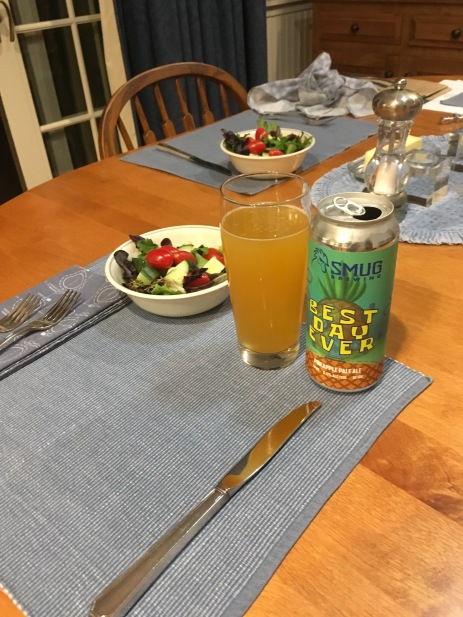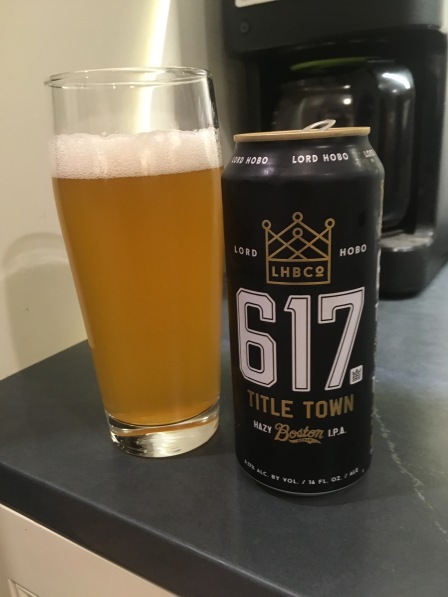There was a section of George Orwell’s 1984 that puzzled me when I first read it as a high-school student, but that makes more sense now, both in view of some time spent in England and some recent developments in beer marketing in the U.S. The question is “What is a good size for a serving of beer?” and it’s an issue because there’s a point in the book when an older man is complaining to the protagonist that a half-liter of beer is too small but a full liter is too much, and the older man wants a good, old-fashioned pint.
I was confused because, to me, the difference between a pint and a half-liter was negligible and both were more than a standard serving. In modern America, one pint is one-eighth of a gallon, or one-half of a quart, which works out to 473 mL, whereas a half-liter would be 500 mL—hardly anything to quibble about. However, sometime in the early nineteenth century (1824 according to Wikipedia), the definition of one pint started to deviate between the United States and England. By the mid-20thcentury (when Orwell was writing), a proper English pint was 20 Imperial fluid ounces, which works out to 568 mL and is enough more to make some (albeit small) difference, and it was enough that the older man wanted a little more than a half-liter, but not a full liter.
I was particularly confused because for my entire life a standard serving of beer in the U.S. has been not even a pint, but 12 fluid ounces or ¾ of a standard pint. This is the size of a standard bottle or can of beer, and also the capacity of a standard “pint” glass that you would get in a bar, as well as the many souvenirs I’ve picked up from tastings over the years. Lately, however, craft brewers are starting to sell beers in 16-ounce cans—still not quite as much as a British pint, but significantly more than what I think of as “a beer.” (I still think back with a little bit of trepidation about whether it was really safe for me to drive home from the pub after two larger British pints with a higher-than-usual ABV on the wrong side of the road during the year that I lived in London. “It was only two beers,” isn’t necessarily convincing under those circumstances.) At any rate, between variations in container size and variations in ABV, there’s a lot of calibration required these days to decide how much alcohol that “one beer” works out to.
Since that difference was on my mind, however, I was enticed by a few “real” pints during my last trip to the beer store, so I came home with some interesting choices.  The most interesting comparison was between two offerings from Stony Creek Brewing: Little Cranky, a session IPA that comes in a 12 oz. can at 4.5% ABV and Big Cranky, a double IPA that comes in a 16 oz. can at 9.5% ABV for more than twice the alcohol. You definitely only need one Big Cranky to get your IPA fix for the day, so I highly recommend keeping this one in the fridge for a night at home or a special occasion.
The most interesting comparison was between two offerings from Stony Creek Brewing: Little Cranky, a session IPA that comes in a 12 oz. can at 4.5% ABV and Big Cranky, a double IPA that comes in a 16 oz. can at 9.5% ABV for more than twice the alcohol. You definitely only need one Big Cranky to get your IPA fix for the day, so I highly recommend keeping this one in the fridge for a night at home or a special occasion.
 Near my hometown, there has been some turnover among craft brewers. One of the latest entries is Smug Brewing, so to support local producers I picked up a four-pack of 16 oz. cans of Best Day Ever. My teen-aged kids informed me that that the name is an homage to SpongeBob SquarePants, which seems appropriate for a very tropical/pineapple-flavored pale ale.
Near my hometown, there has been some turnover among craft brewers. One of the latest entries is Smug Brewing, so to support local producers I picked up a four-pack of 16 oz. cans of Best Day Ever. My teen-aged kids informed me that that the name is an homage to SpongeBob SquarePants, which seems appropriate for a very tropical/pineapple-flavored pale ale.
I’m still enamored with Lord Hobo, so my final 16-ounce pint selection was their 617 Title Town IPA.  I was thinking that, given the name and their Boston-area home base, that the number might have some sort of sports significance related to the Red Sox, Patriots, Celtics, and/or Bruins. It turns out, however, that it’s simply the ABV (6.17%) for this New England IPA–disappointing!
I was thinking that, given the name and their Boston-area home base, that the number might have some sort of sports significance related to the Red Sox, Patriots, Celtics, and/or Bruins. It turns out, however, that it’s simply the ABV (6.17%) for this New England IPA–disappointing!
I’m back to standard 12 oz beers for the short term, but I’m also keeping my eyes open for the occasional 16 oz “real” pint that’s looking to provide a little extra. Cheers!
Pingback: Funeral for a Friend | Dr. Dave's Beer Blog